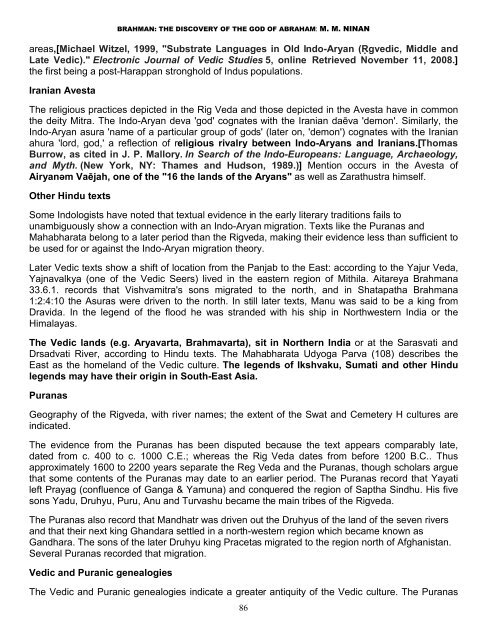Create successful ePaper yourself
Turn your PDF publications into a flip-book with our unique Google optimized e-Paper software.
BRAHMAN: THE DISCOVERY OF THE GOD OF ABRAHAM: M. M. NINAN<br />
areas,[Michael Witzel, 1999, "Substrate Languages in Old Indo-Aryan (Ṛgvedic, Middle and<br />
Late Vedic)." Electronic Journal of Vedic Studies 5, online Retrieved November 11, 2008.]<br />
the first being a post-Harappan stronghold of Indus populations.<br />
Iranian Avesta<br />
The religious practices depicted in the Rig Veda and those depicted in the Avesta have in common<br />
the deity Mitra. The Indo-Aryan deva 'god' cognates with the Iranian daēva 'demon'. Similarly, the<br />
Indo-Aryan asura 'name of a particular group of gods' (later on, 'demon') cognates with the Iranian<br />
ahura 'lord, god,' a reflection of religious rivalry between Indo-Aryans and Iranians.[Thomas<br />
Burrow, as cited in J. P. Mallory. In Search of the Indo-Europeans: Language, Archaeology,<br />
and Myth. (New York, NY: Thames and Hudson, 1989.)] Mention occurs in the Avesta of<br />
Airyanəm Vaējah, one of the "16 the lands of the Aryans" as well as Zarathustra himself.<br />
Other Hindu texts<br />
Some Indologists have noted that textual evidence in the early literary traditions fails to<br />
unambiguously show a connection with an Indo-Aryan migration. Texts like the Puranas and<br />
Mahabharata belong to a later period than the Rigveda, making their evidence less than sufficient to<br />
be used for or against the Indo-Aryan migration theory.<br />
Later Vedic texts show a shift of location from the Panjab to the East: according to the Yajur Veda,<br />
Yajnavalkya (one of the Vedic Seers) lived in the eastern region of Mithila. Aitareya <strong>Brahman</strong>a<br />
33.6.1. records that Vishvamitra's sons migrated to the north, and in Shatapatha <strong>Brahman</strong>a<br />
1:2:4:10 the Asuras were driven to the north. In still later texts, Manu was said to be a king from<br />
Dravida. In the legend of the flood he was stranded with his ship in Northwestern India or the<br />
Himalayas.<br />
The Vedic lands (e.g. Aryavarta, Brahmavarta), sit in Northern India or at the Sarasvati and<br />
Drsadvati River, according to Hindu texts. The Mahabharata Udyoga Parva (108) describes the<br />
East as the homeland of the Vedic culture. The legends of Ikshvaku, Sumati and other Hindu<br />
legends may have their origin in South-East Asia.<br />
Puranas<br />
Geography of the Rigveda, with river names; the extent of the Swat and Cemetery H cultures are<br />
indicated.<br />
The evidence from the Puranas has been disputed because the text appears comparably late,<br />
dated from c. 400 to c. 1000 C.E.; whereas the Rig Veda dates from before 1200 B.C.. Thus<br />
approximately 1600 to 2200 years separate the Reg Veda and the Puranas, though scholars argue<br />
that some contents of the Puranas may date to an earlier period. The Puranas record that Yayati<br />
left Prayag (confluence of Ganga & Yamuna) and conquered the region of Saptha Sindhu. His five<br />
sons Yadu, Druhyu, Puru, Anu and Turvashu became the main tribes of the Rigveda.<br />
The Puranas also record that Mandhatr was driven out the Druhyus of the land of the seven rivers<br />
and that their next king Ghandara settled in a north-western region which became known as<br />
Gandhara. The sons of the later Druhyu king Pracetas migrated to the region north of Afghanistan.<br />
Several Puranas recorded that migration.<br />
Vedic and Puranic genealogies<br />
The Vedic and Puranic genealogies indicate a greater antiquity of the Vedic culture. The Puranas<br />
86


















